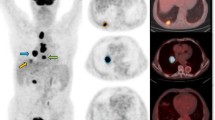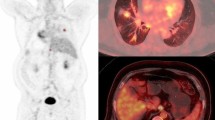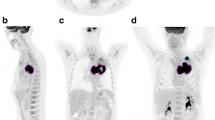Abstract
Purpose
To determine whether whole-body metabolic tumor burden, measured as either metabolic tumor volume (MTVWB) or total lesion glycolysis (TLGWB), using FDG-PET/CT is an independent prognostic marker in non-small cell lung cancer (NSCLC).
Methods
328 patients with histologically proven NSCLC were identified for this retrospective analysis. This study was approved by our Institutional Review Board. All patients underwent baseline 18F-FDG-PET/CT scan imaging before therapy. The MTVWB, TLGWB, maximum standardized uptake value (SUVmaxWB) and mean standardized uptake value (SUVmeanWB) of tumors throughout the whole body were measured from FDG-PET images with semi-automated 3D contouring software.
Results
In univariate analysis, there was a statistically significant association of overall survival (OS) with the MTVWB (hazard ratio (HR) = 1.62, p < 0.001), TLGWB (HR = 1.47, p < 0.001). The patients with a MTVWB ≤ median of 65.7 ml and TLGWB ≤ median of 205.11 SUVmean * ml had a median OS of 41.1 and 35.4 months compared with 9.5 and 9.7 months for those with a MTVWB > 65.7 ml and TLGWB > 205.11 SUVmean * ml, respectively. From a series of multivariate Cox regression models, the MTVWB and TLGWB were significantly better than SUVmaxWB and SUVmeanWB at prognostication and significantly associated with patients’ OS with HRs of 1.50 (p < 0.001) and 1.42 (p < 0.001), respectively, after adjustment for patient’s age, gender and treatment intent as well as the tumor SUVmaxWB, histology and stage.
Conclusions
MTVWB and TLGWB as metabolic tumor burden measurements in 18F-FDG-PET/CT are independent prognostic markers and are significantly better than SUVmaxWB and SUVmeanWB at prognostication.
Similar content being viewed by others
References
Parkin DM, Bray FI, Devesa SS (2001) Cancer burden in the year 2000. The global picture. Eur J Cancer 37(Suppl 8): S4–S66
Maldonado A, Gonzalez-Alenda FJ, Alonso M, Sierra JM (2007) Usefulness of positron emission tomography-computed tomography in respiratory medicine. Arch Bronconeumol 43: 562–572
Sugawara Y, Zasadny KR, Neuhoff AW, Wahl RL (1999) Reevaluation of the standardized uptake value for FDG: variations with body weight and methods for correction. Radiology 213: 521–525
Hamberg LM, Hunter GJ, Alpert NM, Choi NC, Babich JW, Fischman AJ (1994) The dose uptake ratio as an index of glucose metabolism: useful parameter or oversimplification?. J Nucl Med 35: 1308–1312
Weber WA, Schwaiger M, Avril N (2000) Quantitative assessment of tumor metabolism using FDG-PET imaging. Nucl Med Biol 27: 683–687
Lee P, Weerasuriya DK, Lavori PW, Quon A, Hara W, Maxim PG, Le QT, Wakelee HA, Donington JS, Graves EE, Loo BW Jr. (2007) Metabolic tumor burden predicts for disease progression and death in lung cancer. Int J Radiat Oncol Biol Phys 69: 328–333
Raben D, Chen C, Loo B, Graves E, Kavanagh B (2009) Metabolic tumor volume and oropharynx subsite as prognostic factors in advanced head and neck cancer. Int J Radiat Oncol 75: S412
Larson SM, Erdi Y, Akhurst T, Mazumdar M, Macapinlac HA, Finn RD, Casilla C, Fazzari M, Srivastava N, Yeung HW, Humm JL, Guillem J, Downey R, Karpeh M, Cohen AE, Ginsberg R (1999) Tumor treatment response based on visual and quantitative changes in global tumor glycolysis using PET-FDG imaging. The visual response score and the change in total lesion glycolysis. Clin Positron Imaging 2: 159–171
Lee P, Bazan JG, Lavori PW, Weerasuriya DK, Quon A, Le Q-T, Wakelee HA, Graves EE, Loo BW (2012) Metabolic tumor volume is an independent prognostic factor in patients treated definitively for non-small-cell lung cancer. Clin Lung Cancer 13: 52–58
Liao S, Penney BC, Wroblewski K, Zhang H, Simon CA, Kampalath R, Shih MC, Shimada N, Chen S, Salgia R, Appelbaum DE, Suzuki K, Chen CT, Pu Y (2012) Prognostic value of metabolic tumor burden on 18F-FDG PET in nonsurgical patients with non-small cell lung cancer. Eur J Nucl Med Mol Imaging 39(1): 27–38
Liao S, Penney BC, Zhang H, Suzuki K, Pu Y (2012) Prognostic value of the quantitative metabolic volumetric measurement on 18F-FDG PET/CT in stage IV nonsurgical small-cell lung cancer. Acad Radiol 19(1): 69–77
Mountain CF (1997) Revisions in the international system for staging lung cancer. Chest 111: 1710–1717
Grivaux M, Zureik M, Marsal L, Asselain B, Peureux M, Chavaillon JM, Prud’homme A, Carbonnelle M, Goarant E, Maury B, Bedossa A, Blanchon F (2009) Five year survival for lung cancer patients managed in general hospitals. Rev Mal Respir 26: 37–44
Spira A, Ettinger DS (2004) Multidisciplinary management of lung cancer. N Engl J Med 350: 379–392
Socinski MA, Morris DE, Masters GA, Lilenbaum R (2003) Chemotherapeutic management of stage IV non-small cell lung cancer. Chest 123: 226S–243S
Borst GR, Belderbos JSA, Boellaard R, Comans EFI, de Jaeger KD, Lammertsma AA, Lebesque JV (2005) Standardized FDG uptake: a prognostic factor for inoperable non-small cell lung cancer. Eur J Cancer 41: 1533–1541
Davies A, Tan C, Paschalides C, Barrington S, O’Doherty M, Utley M, Treasure T (2007) FDG-PET maximum standardised uptake value is associated with variation in survival: analysis of 498 lung cancer patients. Lung Cancer 55: 75–78
van Baardwijk A, Dooms C, van Suylen RJ, Verbeken E, Hochstenbag M, Dehing-Oberije C, Rupa D, Pastorekova S, Stroobants S, Buell U, Lambin P, Vansteenkiste J, De Ruysscher D (2007) The maximum uptake of (18)F-deoxyglucose on positron emission tomography scan correlates with survival, hypoxia inducible factor-1alpha and GLUT-1 in non-small cell lung cancer. Eur J Cancer 43: 1392–1398
Geus-Oei LF, Oyen WJ (2008) Predictive and prognostic value of FDG-PET. Cancer Imaging 8: 70–80
UyBico SJ, Wu CC, Suh RD, Le NH, Brown K, Krishnam MS (2010) Lung cancer staging essentials: the new TNM staging system and potential imaging pitfalls. Radiographics 30: 1163–1181
Shankar LK, Hoffman JM, Bacharach S, Graham MM, Karp J, Lammertsma AA, Larson S, Mankoff DA, Siegel BA, Vanden Abbeele A, Yap J, Sullivan D (2006) Consensus recommendations for the use of 18F-FDG PET as an indicator of therapeutic response in patients in National Cancer Institute trials. J Nucl Med 47: 1059–1066
Werner-Wasik M, Nelson AD, Choi W, Arai Y, Faulhaber PF, Kang P, Almeida FD, Xiao Y, Ohri N, Brockway KD, Piper JW, Nelson AS (2012) What is the best way to contour lung tumors on PET scans? Multiobserver validation of a gradient-based method using a NSCLC digital PET phantom. Int J Radiat Oncol Biol Phys. 82(3): 1164–1171
Houseni M, Chamroonrat W, Zhuang J, Gopal R, Alavi A, Zhuang H (2010) Prognostic implication of dual-phase PET in adenocarcinoma of the lung. J Nucl Med 51: 535–542
Cox DR (1972) Regression models and life-tables (with discussion). J R Stat Soc Series B (Methodol) 34: 817–220
Grambsch PM, Therneau TM (1994) Proportional hazards tests and diagnostics based on weighted residuals. Biometrika 81: 515–526
Gönen M, Heller G (2005) Concordance probability and discriminatory power in proportional hazards regression. Biometrika 92: 965–970
Goldstraw P, Crowley J, Chansky K, Giroux DJ, Groome PA, Rami-Porta R, Postmus PE, Rusch V, Sobin L (2007) The IASLC Lung Cancer Staging Project: proposals for the revision of the TNM stage groupings in the forthcoming (seventh) edition of the TNM Classification of malignant tumours. J Thorac Oncol 2: 706–714
Pelosi E, Billè A, Skanjeti A, Errico L, Arena V, Ardissone F, Borasio P, Mancini M (2011) Prognostic role of the PET parameter maximum standardized uptake value in non small cell lung cancer: analysis in tumour of diameter ≥ and < 25 mm. Q J Nucl Med Mol Imaging 55: 72–80
Oven UBB, Gumus M, Bilici A, Seker M, Ustaalioglu R, Kefeli U, Salepci T, Canpolat N, Mayadagli A, Dogusoy I (2010) Is there a cut-off value for standardized uptake values in positron emission tomography for predicting response to treatment and survival in patients with advanced non-small cell lung cancer? Single center experience. J Balkan Union Oncol 15: 529–536
Imamura Y, Azuma K, Kurata S, Hattori S, Sasada T, Kinoshita T, Okamoto M, Kawayama T, Kaida H, Ishibashi M, Aizawa H (2011) Prognostic value of SUVmax measurements obtained by FDG-PET in patients with non-small cell lung cancer receiving chemotherapy. Lung Cancer 71: 49–54
Um SW, Kim H, Koh WJ, Suh GY, Chung MP, Kwon OJ, Choi JY, Han J, Lee KS, Kim J (2009) Prognostic value of 18F-FDG uptake on positron emission tomography in patients with pathologic stage I non-small cell lung cancer. J Thorac Oncol 4: 1331–1336
Nair VS, Barnett PG, Ananth L, Gould MK (2010) PET scan 18F-fluorodeoxyglucose uptake and prognosis in patients with resected clinical stage IA non-small cell lung cancer. Chest 137: 1150–1156
Hanin FX, Lonneux M, Cornet J, Noirhomme P, Coulon C, Distexhe J, Poncelet AJ (2008) Prognostic value of FDG uptake in early stage non-small cell lung cancer. Eur J Cardiothorac Surg 33: 819–823
Nambu A, Kato S, Sato Y, Okuwaki H, Nishikawa K, Saito A, Matsumoto K, Ichikawa T, Araki T (2009) Relationship between maximum standardized uptake value (SUVmax) of lung cancer and lymph node metastasis on FDG-PET. Ann Nucl Med 23: 269–275
Liu S, Cheng H, Yao S, Wang C, Han G, Li X, Liu C (2010) The clinical application value of PET/CT in adenocarcinoma with bronchioloalveolar carcinoma features. Ann Nucl Med 24: 541–547
Visbal AL, Williams BA, Nichols FC 3rd, Marks RS, Jett JR, Aubry MC, Edell ES, Wampfler JA, Molina JR, Yang P (2004) Gender differences in non-small-cell lung cancer survival: an analysis of 4,618 patients diagnosed between 1997 and 2002. Ann Thorac Surg 78: 209–215
Agarwal M, Brahmanday G, Chmielewski GW, Welsh RJ, Ravikrishnan KP (2010) Age, tumor size, type of surgery, and gender predict survival in early stage (stage I and II) non-small cell lung cancer after surgical resection. Lung Cancer 68: 398–402
Demura Y, Tsuchida T, Ishizaki T, Mizuno S, Totani Y, Ameshima S, Miyamori I, Sasaki M, Yonekura Y (2003) 18F-FDG accumulation with PET for differentiation between benign and malignant lesions in the thorax. J Nucl Med 44: 540–548
Author information
Authors and Affiliations
Corresponding author
Rights and permissions
About this article
Cite this article
Zhang, H., Wroblewski, K., Appelbaum, D. et al. Independent prognostic value of whole-body metabolic tumor burden from FDG-PET in non-small cell lung cancer. Int J CARS 8, 181–191 (2013). https://doi.org/10.1007/s11548-012-0749-7
Received:
Accepted:
Published:
Issue Date:
DOI: https://doi.org/10.1007/s11548-012-0749-7




